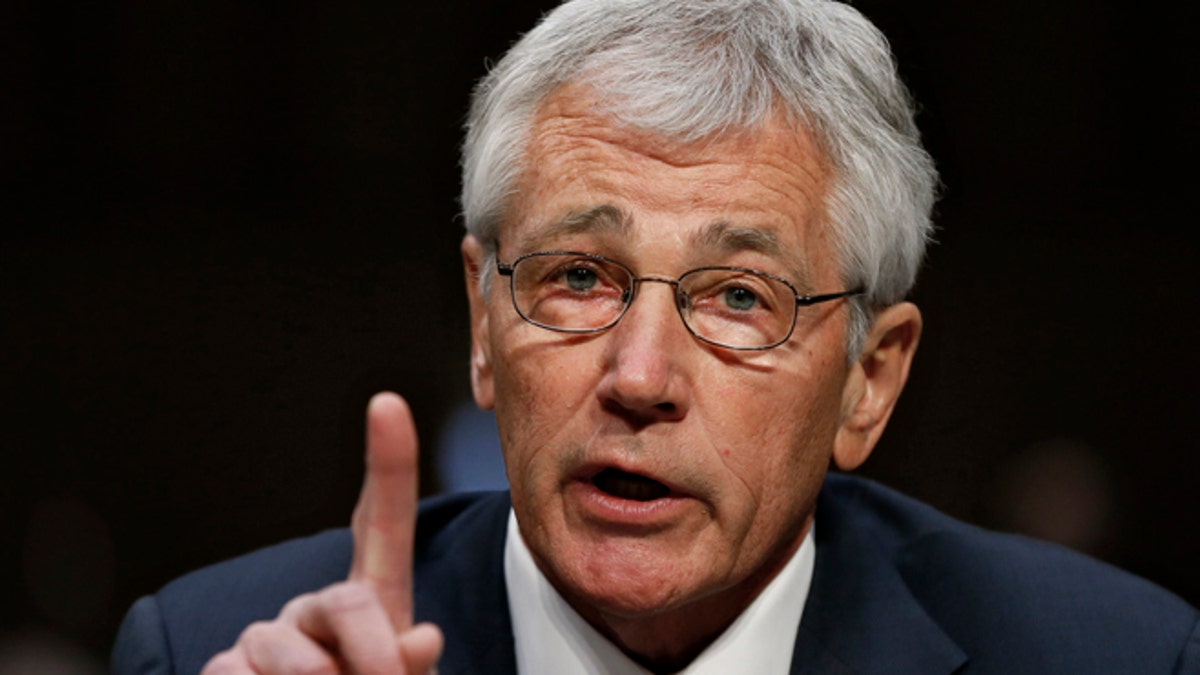
Defense Secretary Chuck Hagel testifies on Capitol Hill in Washington, Wednesday, March 5, 2014, before the Senate Armed Services Committee hearing on the Defense Departments budget request for fiscal year 2015. (AP)
According to Secretary of Defense Chuck Hagel’s Feb. 24 speech, “We are repositioning to focus on the strategic challenges and opportunities that will define our future …” How close does he come?
This will be the first budget to fully embrace the transition the DoD is making after the longest conflict in our nation’s history.
The key components: reduction of troops to pre-World War II levels and the retirement of aging weapons systems. A large percentage of the 2015 defense budget will be devoted to development of long-range and unmanned defense technologies as well as investing in cyberwarfare. But will these choices help insure we have the right “cards” in our hand as we play out the global game of national security poker?
[pullquote]
While the proposed budget shows progress, the Pentagon insists on spending at historical highs, budgeting $80 billion in “slush fund” Overseas Contingency Operations (OCO). Not wise. This has become the Pentagon’s method of bypassing congressional budget caps – and needs to be corrected. But I digress.
Currently, China and Russia are in the developmental stages of creating precision anti-ship missiles to establish “anti-access” area denial weapons systems to deter adversaries from operating along their coastlines.
These nations are also developing stealth aircraft equipped with anti-ship missiles, capable of hypersonic speeds.
What this means is this: the United States may be losing the leading edge in military technology.
Because of this concern, it is paramount that the DoD focus on new technology to enhance our 21st century defensive and offensive capabilities, rather than continuing a false sense of security with the use of ground troops. The Pentagon budget proposal is correct for this purpose; this is the face of 21st century warfare.
Concurrently, the Pentagon is developing long-range, multi-mission oriented technology – Boeing’s P-8A Poseidon long-range maritime spy plane, Lockheed Martin’s F-35 Series Joint Strike Fighter, Northrop Grumman’s RQ-4 Global Hawk, as well as the development of laser and other exotic weaponry.
Controversy has followed the development and fielding of F-35; questions remain about its ability to meet or exceed performance expectations that, in turn, will justify the decommissioning of the F-16, F/A-18, EA-6B, A-10 and AV-8B.
And large issues remain as to the F-35’s cost effectiveness.3 Even F-35 opponent Winslow Wheeler admits in his series of reports for Time magazine that “Without a complete and independent audit of the F-35 program…it is impossible to discern which F-35 cost reports, if any, are accurate, and precisely what F-35 costs are today and will be in the future.”
The reported 2014 spending costs for the F-35 program were roughly $6 billion – out of the proposed $572 billion that was allotted for the total defense budget – putting the F-35 program at approximately 1 percent of the total annual defense budget.
The intent is to retire the A-10 by 2028. This program’s elimination will free up approximately $3.5 billion over five years; this would help compensate for the funding required for the continuation of the F-35 program.
On the positive side, test pilots who have flown the F-35 have praised its operations and new technologies and feel that it can replace the A-10.4 However, skeptics (I’m one) are concerned that during other test runs there were malfunctions in equipment that may delay the official launch of the program set for 2015 and further increase the proposed cost per unit (which has already doubled since the start of the program).
The A-10 is proven, reliable, upgradable and survivable and, based on the anticipated threats we expect to see, a weapon system that could be effective and sustainable with a lifespan similar to that of the B-52; I’m not seeing the upside here of the A-10’s elimination.
A wise move in the budget proposal is the expansion of special operations forces.
In the 2015 request, special operations forces will grow by 4000 personnel (bringing the total to 69,700), an acceptance of the reality that the nation is likely to face from asymmetrical threats in the future.
With a new focus on cyberwarfare, the DoD has budgeted between $4.7 – 5.1 billion. Spending on cyberwarfare, to date, has been largely ineffective and unfocused.
Because of expanded cyber-espionage 7and their utilization of cyberattacks for the purpose of intellectual property theft as well originating from America’s adversaries like China, Iran and North Korea it is necessary that the DoD establish an effective cyberwarfare capability.
In the end, does the DoD’s 2015 Budget proposal correlate with the Obama administration’s expectations of strengthening our defenses and combating new threats, like cyberterrorism, while investing in the capabilities our servicemen and women need to succeed in future missions? I’ll have to say: “mostly, but not completely.”
As we learned during the Cold War, victory is not about having one single card in the great game of global poker -- it is about having the right cards in your hand, at the right time and playing them effectively.
This budget is progress, but not perfection.
Given Hagel’s agenda, this will give him a good hand to play. This moves us in the right direction to maintain a technology lead in the evolving global challenges as well as protection of the homeland (within a sustainable budget).
